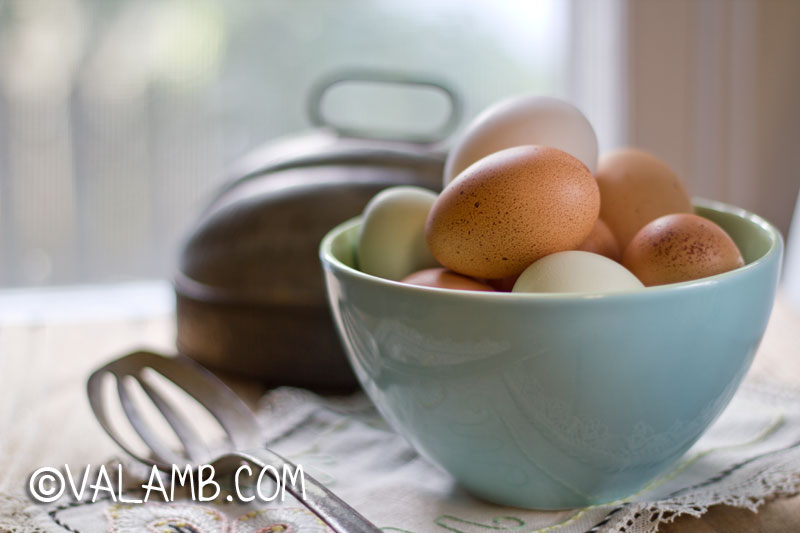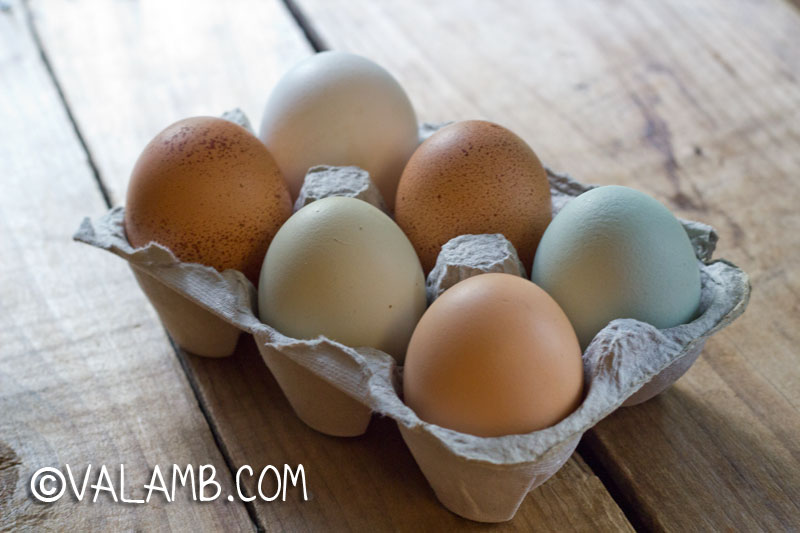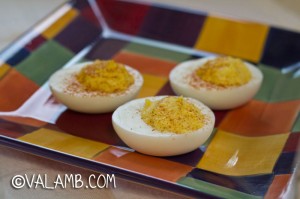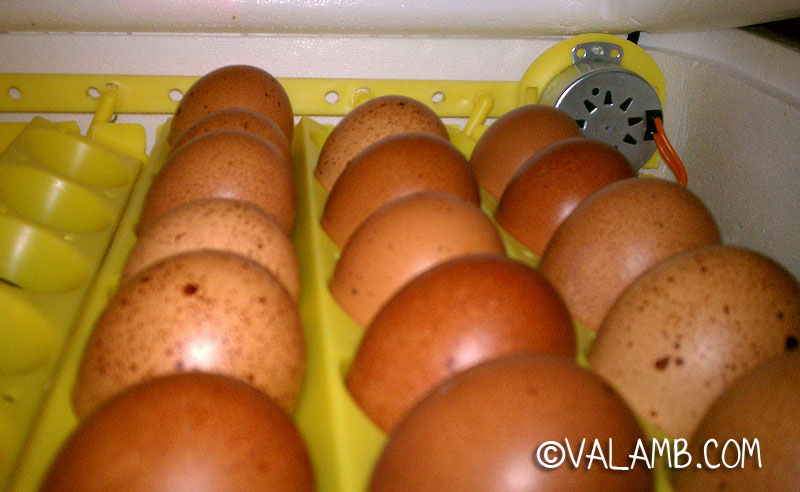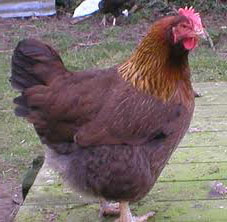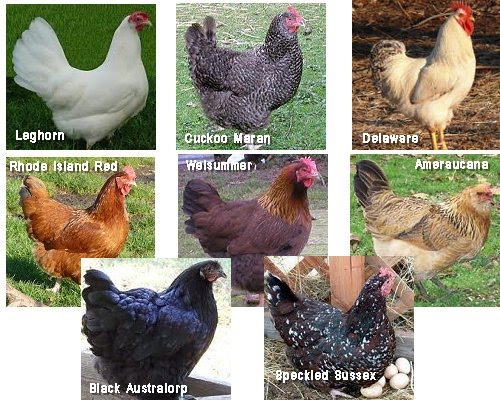
Over the past couple of months the percentages of brown, white, and green eggs that we sell weekly has slowly been changing. For you curious foodies, we thought we’d explain why.
Choosing Our Flock
When developing our laying flock, we looked for several things in the hens we chose. First, we wanted to concentrate on heritage breeds and those that were known to be good foragers. Next, we focused on egg production, egg color and size. Even though they are on pasture most of the year, the girls still need to earn their stay. Hardiness was our next consideration. We looked for a balance of winter and summer hardy birds as well as winter and summer layers; the more categories they fell into the higher they were on the list.
Although the above characteristics where our top priority, bonus traits included friendly, easy going dispositions, below average flying ability (Boy, do we hate chasing those few that insist on getting out!), and overall appearance.
So, are you still wondering why the color of our eggs varies from summer to winter? Basically, as the weather turns cold certain breeds will begin to lay fewer eggs while others continue strong. Right now our white egg layers seem to have hit their prime. If you purchased a dozen eggs from us this week you may have noticed a few additional white eggs in the mix. Be sure to savior these as special treats as these twelve girls (yep! there are only twelve!) are working extra hard to make the rest of the flock look good.
Below is our description of the laying hens that make their home at Virginia Lamb.
Breed: Delaware
This breed is an American Heritage (1940) breed. Their characteristics include early maturing (start laying younger), dual purpose (males make great broilers too), calm disposition, and they are excellent foragers.
They are good layers (4-5 eggs/wk) and produce large to x-large light brown eggs. They are cold and heat tolerant; and they continue laying all winter.
Breed: Rhode Island Reds
Most of the eggs being sold at farmers markets come from sex-linked offspring of the RIR. We have a few of both. The full pedigree Rhode Island Reds are a heritage breed and fairly easy going in nature.
They are excellent egg layers (5-6/wk) and produce x-large brown eggs. They are extremely cold hardy and will continue laying all winter long. The term sex-linked (think crossbred) comes from being able to tell the females from the males at birth based on color. This is not the case with most purebreds. Our sex-links are smaller in size, eat less, are somewhat flighty and aren’t as winter hardy. We purchased a handful as a comparison to our full RIR. Based on their differences, they were most likely bred to meet the needs of confinement operations. Although off to a slow start; ours are adjusting well.
Breed: Black Australorps
This is an Australian heritage breed and has a shy but sweet disposition. They are excellent egg layers (5-6/wk) and produce large brown eggs. They are winter and summer hardy.
They were added to our flock specifically because they stand up well and continue laying through even the hottest summer when many breeds taper off.
Breed: Welsummer
This breed originates from Holland and has proven to be a very good forager.
They are good egg layers (~4/wk), producing large eggs. They are cold hardy. However, they are best known and prized for their egg color. In Europe, chefs seek out and pay dearly for these eggs. The deepest colored eggs are dark terracotta and can be speckled. We will continue to add more of these hens to our flock. Watch for their beautiful eggs next summer!
Breed: Ameraucana
An American breed that traces its history back to Chile. These goofy looking (said with love, mind you!) birds are responsible for all those green and blue eggs in your cartons.
They are good layers (~4/wk) and cold tolerant. The hens themselves range in color from silver, blue, buff, red, white, and a mix of all of the above. Most of ours have ear tuffs (small feathers on the side of their heads) and longer necks.
Breed: Speckled Sussex
This is an English heritage, dual purpose breed. They are exceptionally friendly, forage well (especially around one’s shoes) and can’t fly worth a darn (makes up for the shoe comment)!
They are very good layers (4-5/wk) of large tinted or beige eggs. They are extremely cold hardy and lay throughout the summer and winter.
Although my list actually included, not the Speckled, but the Light Sussex, we become the proud owner of these after meeting a very adorable, big eyed 4-Her at our county fair.
Breed: White Leghorn
This Italian breed came to America in 1840 and now makes up the parentage of most commercial white laying operations. They are small birds, surprisingly good foragers, and alert and active (read noisy and flighty!). Bad news is they are also gifted flyers!
They are excellent layers (5-6/wk) of x-large white eggs. They are cold hard and are proving to be exceptionally good winter layers.
Ok, now my soap box… Recently we had a potential customer tell us that farm fresh eggs could not be white. Okay!?!? I know we have become accustomed to thinking of brown eggs as farm fresh. I love brown eggs too! But I promise you our white eggs are just as tasty and fresh! As I said above, be sure to savior these special treats as these twelve girls are working extra hard right now to fill out our egg cartons just for you! 
Breed: Cuckoo Marans
This is a French heritage, dual purpose breed. They are large birds that will brood (i.e. like to stay in the laying boxes and not give up their eggs).
They are above average layers (3-4/wk) and are here only because I am a sucker for their beautiful large dark chocolate colored eggs. Oh, did I mention, they don’t like the winter weather.
As these fade out, I am hoping to replace them with Black Copper Marans. Very similar in egg color with a better production rate.
Well I hope you have enjoyed today’s chicken lesson and getting to know those truly responsible for your delicious eggs each week. Be sure to stop by and pick-up your dozen eggs next Sunday!

